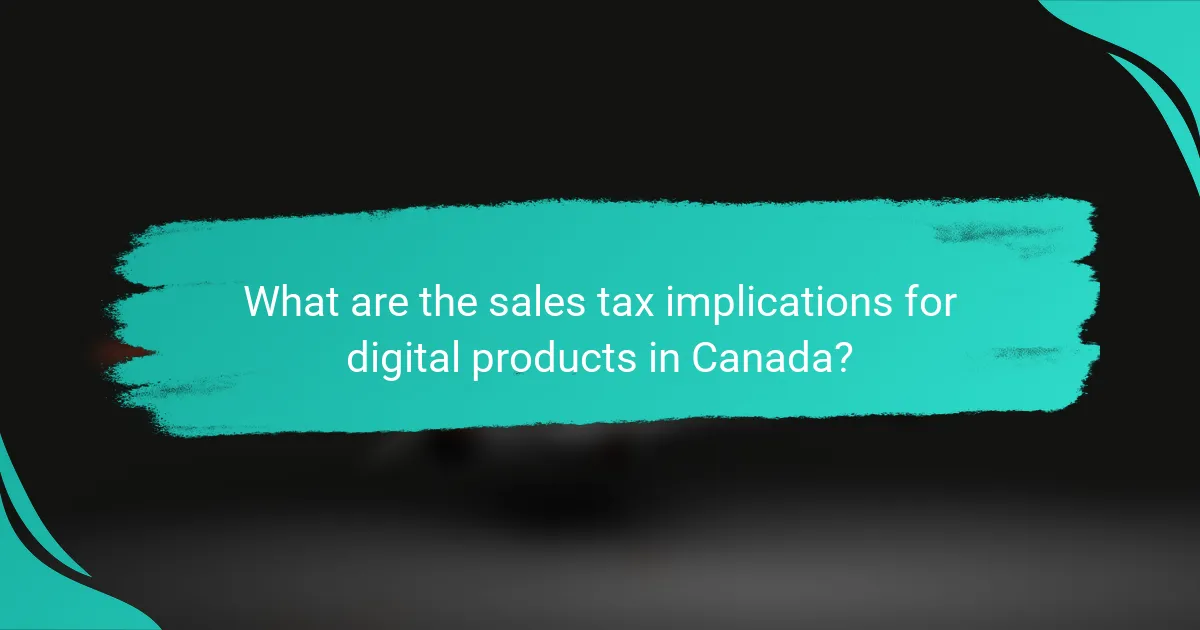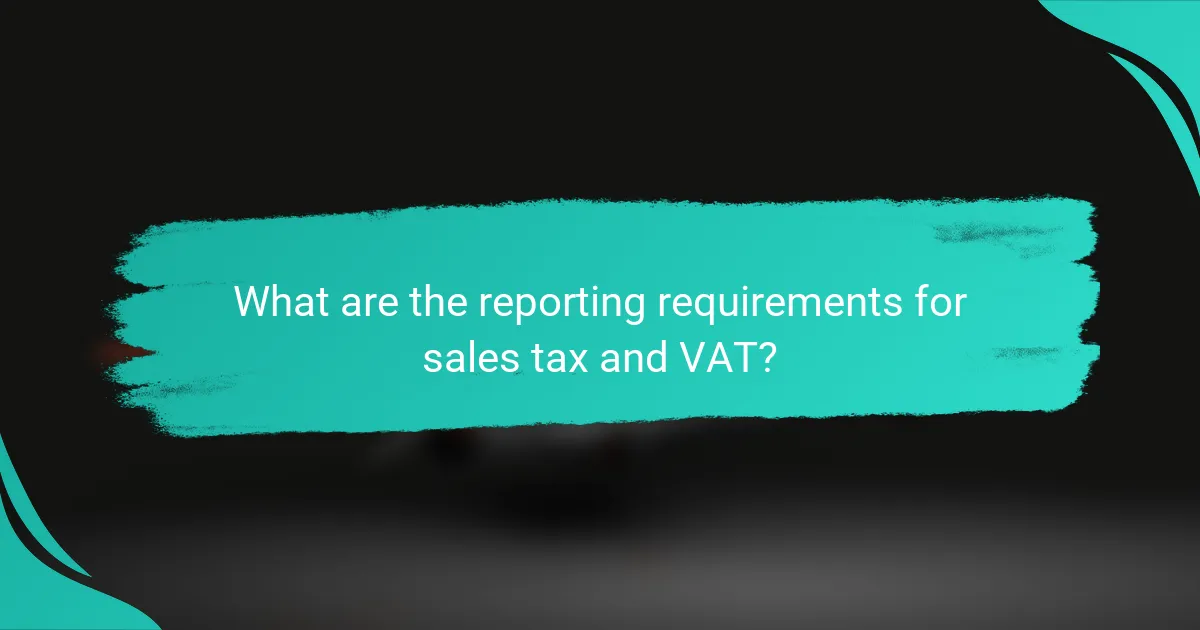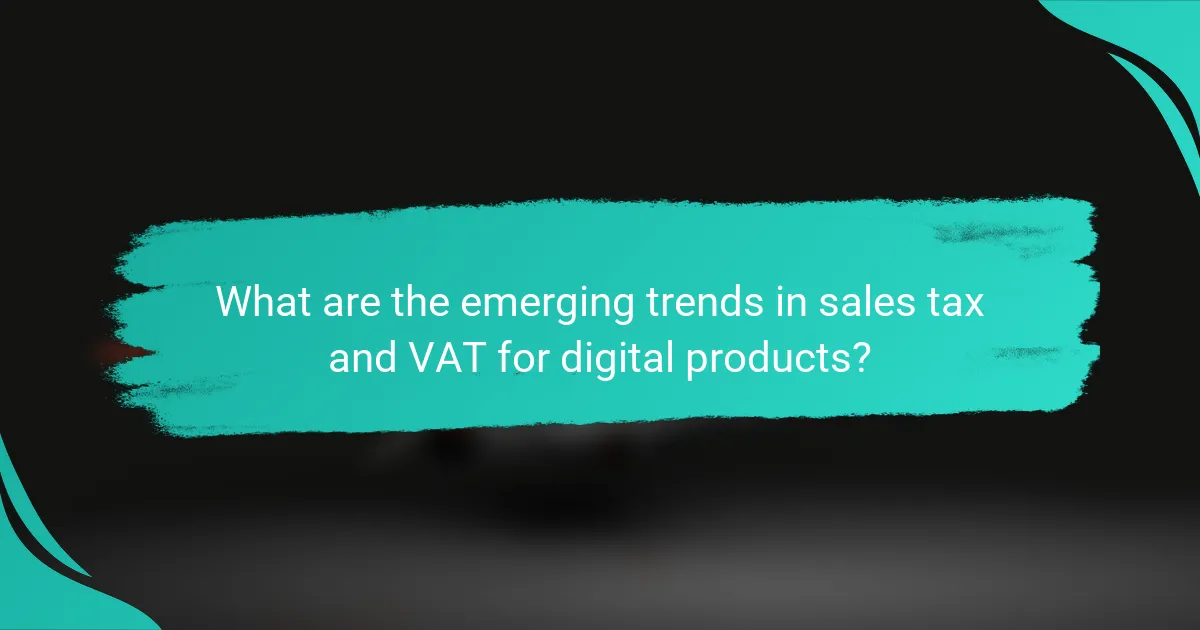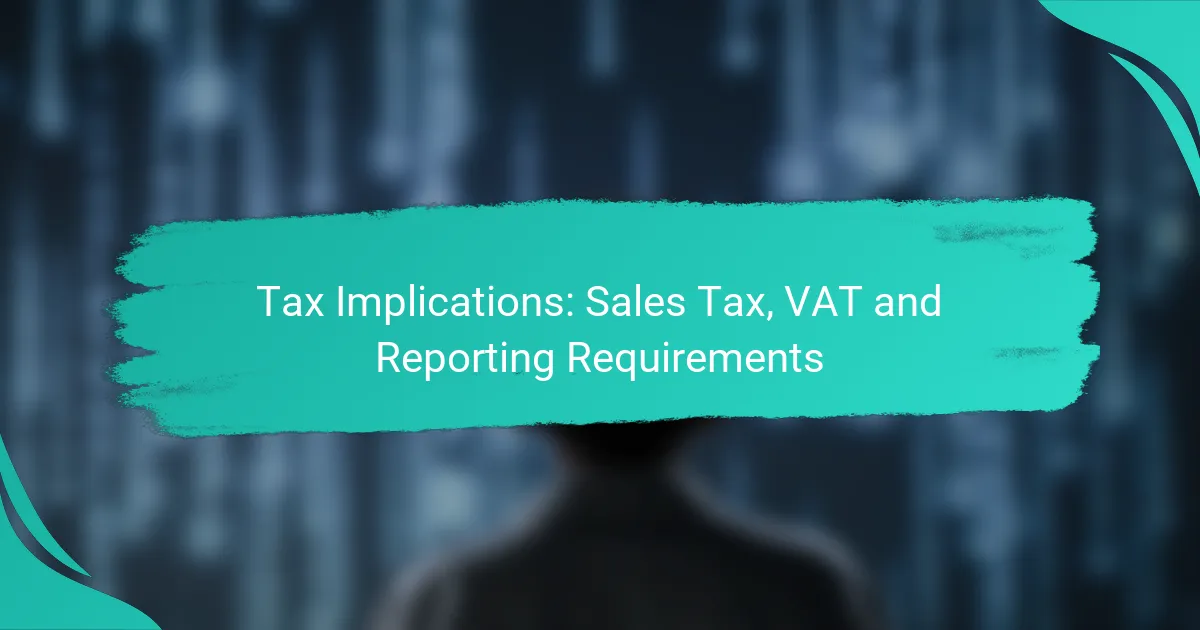Understanding the tax implications of selling digital products is crucial for businesses operating in Canada, where both sales tax and Value Added Tax (VAT) apply. Companies must navigate the complexities of the Goods and Services Tax (GST) and Harmonized Sales Tax (HST), as well as adhere to specific reporting requirements to maintain compliance. Accurate record-keeping and timely submissions to tax authorities are essential to avoid penalties and ensure smooth operations.

What are the sales tax implications for digital products in Canada?
In Canada, digital products are generally subject to sales tax, which includes both the Goods and Services Tax (GST) and the Harmonized Sales Tax (HST), depending on the province. Businesses selling digital goods must understand their tax obligations to ensure compliance and avoid penalties.
Taxable digital products
Taxable digital products in Canada include items such as e-books, online courses, software downloads, and streaming services. These products are treated similarly to physical goods for tax purposes, meaning that sales tax must be collected at the point of sale. Businesses should clearly indicate the applicable tax on invoices to maintain transparency.
Digital services, like website hosting or digital advertising, are also taxable. It is crucial for sellers to classify their offerings correctly to apply the appropriate tax rates.
Exemptions and exceptions
Some digital products may be exempt from sales tax in Canada. For instance, certain educational materials provided by recognized institutions can qualify for exemptions. Additionally, products that are considered to be “zero-rated” may not incur tax, allowing businesses to charge 0% GST/HST while still claiming input tax credits.
It’s essential to review the specific criteria for exemptions, as they can vary based on the nature of the product and the province in which the sale occurs. Businesses should keep documentation to support any claims for exemptions.
Provincial variations
Sales tax rates and regulations for digital products can vary significantly across Canadian provinces. For example, provinces like British Columbia charge a provincial sales tax (PST) in addition to GST, while others, like Ontario, use HST. This means that a digital product sold in Ontario may incur a higher tax rate than the same product sold in Alberta, which has no provincial sales tax.
Businesses should be aware of the specific tax rates and rules in each province where they operate. Keeping up-to-date with provincial regulations is essential for compliance and accurate tax reporting.

How does VAT affect digital products sold in Canada?
In Canada, the Value Added Tax (VAT) applies to digital products, requiring sellers to charge VAT on sales to consumers. This tax impacts pricing and compliance, making it essential for businesses to understand their obligations.
VAT registration requirements
Businesses selling digital products in Canada must register for VAT if their taxable sales exceed a certain threshold, which is typically around CAD 30,000 annually. This registration allows them to collect VAT from customers and remit it to the government.
Even if a business’s sales are below this threshold, it may still choose to register voluntarily. This can be beneficial for claiming input tax credits on purchases related to their digital products.
Applicable VAT rates
The standard VAT rate for digital products in Canada is generally 5%, known as the Goods and Services Tax (GST). However, some provinces have harmonized their provincial sales tax with the GST, resulting in combined rates that can reach up to 15% in total.
For example, in provinces like Ontario, the Harmonized Sales Tax (HST) is applied at a rate of 13%. Businesses should be aware of the specific rates applicable in each province where they sell digital products to ensure accurate tax collection.

What are the reporting requirements for sales tax and VAT?
Sales tax and VAT reporting requirements vary by jurisdiction but generally involve regular submissions to tax authorities detailing collected taxes. Businesses must keep accurate records and submit reports on a specified schedule to ensure compliance and avoid penalties.
Filing frequency
The frequency of filing sales tax and VAT returns typically depends on the volume of taxable sales. Many jurisdictions require monthly filings for businesses with high sales, while smaller businesses may file quarterly or annually. It’s essential to check local regulations to determine the correct filing frequency.
For example, in the United States, states like California may require monthly filings for businesses collecting significant sales tax, whereas others may allow quarterly or annual filings for smaller operations. In the EU, VAT returns are often filed quarterly or annually, depending on the member state.
Documentation needed
To comply with sales tax and VAT reporting requirements, businesses must maintain thorough documentation. This includes invoices, receipts, and records of sales transactions, which serve as proof of tax collected and paid. Accurate records help in preparing reports and can be crucial during audits.
Common documents needed include sales invoices, purchase receipts, and records of tax-exempt transactions. It’s advisable to keep these records for several years, as many jurisdictions require documentation to be retained for a minimum of three to five years.

What are the compliance challenges for digital product sellers?
Digital product sellers face significant compliance challenges due to varying sales tax and VAT regulations across different jurisdictions. Understanding these complexities is crucial for maintaining compliance and avoiding penalties.
Understanding tax jurisdictions
Tax jurisdictions refer to the specific areas where different tax laws apply, which can vary widely even within a single country. For digital product sellers, this means they must identify where their customers are located and the applicable tax rates for those regions.
For example, in the European Union, VAT rates differ by member state, ranging from around 17% to 27%. Sellers must ensure they are registered for VAT in the appropriate jurisdictions to comply with local laws.
Managing multiple tax rates
Managing multiple tax rates can be complex, especially for sellers operating in multiple regions. Each jurisdiction may have its own rules regarding exemptions, thresholds, and reporting requirements, making it essential to stay informed about changes.
A practical approach is to use automated tax calculation tools that can help track and apply the correct rates based on the customer’s location. Sellers should also regularly review their tax compliance processes to avoid common pitfalls, such as underreporting or failing to register in a new jurisdiction.

How can digital product businesses streamline tax compliance?
Digital product businesses can streamline tax compliance by leveraging technology and expert advice. Implementing tax automation software and consulting with tax professionals can significantly reduce the complexity of managing sales tax and VAT obligations.
Using tax automation software
Tax automation software helps digital product businesses manage sales tax and VAT calculations efficiently. These tools can automatically calculate the correct tax rates based on the customer’s location, ensuring compliance with local regulations.
When selecting tax automation software, consider features like integration with your e-commerce platform, real-time updates on tax rates, and reporting capabilities. Popular options include TaxJar, Avalara, and Vertex, which cater to various business sizes and needs.
To maximize the benefits, regularly review and update your software settings to reflect any changes in tax laws or product offerings. This proactive approach can help avoid costly penalties and streamline your reporting processes.
Consulting tax professionals
Engaging tax professionals can provide tailored guidance for navigating the complexities of sales tax and VAT compliance. These experts can help identify applicable tax obligations and ensure that your business adheres to local regulations.
When choosing a tax consultant, look for someone with experience in digital products and familiarity with the jurisdictions where you operate. They can assist with tax planning strategies, audit support, and ongoing compliance monitoring.
Consider scheduling regular check-ins with your tax advisor to stay informed about changes in tax laws that may affect your business. This ongoing relationship can be invaluable in maintaining compliance and optimizing your tax strategy.

What are the emerging trends in sales tax and VAT for digital products?
Emerging trends in sales tax and VAT for digital products include increasing regulatory scrutiny and the push for global tax harmonization. As digital commerce expands, jurisdictions are adapting their tax frameworks to capture revenue from online sales more effectively.
Global tax harmonization efforts
Global tax harmonization efforts aim to create a consistent framework for taxing digital products across different countries. This includes initiatives by organizations such as the OECD to establish guidelines that member countries can adopt, reducing compliance burdens for businesses operating internationally.
For example, the OECD’s Base Erosion and Profit Shifting (BEPS) project encourages countries to align their tax policies, which can lead to a more predictable tax environment for digital goods. Businesses should stay informed about these developments to ensure compliance and optimize their tax strategies.
Impact of e-commerce regulations
E-commerce regulations significantly impact how sales tax and VAT are applied to digital products. Many countries have introduced rules requiring online sellers to collect taxes based on the buyer’s location, which can vary widely in rates and compliance requirements.
For instance, in the European Union, the VAT rates for digital services can range from around 17% to 27%, depending on the member state. Companies selling digital products must understand these regulations to avoid penalties and ensure proper tax collection.
